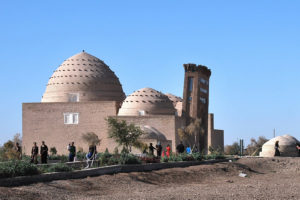 Konye-Urgench (Konye-Urgench) – the architectural reserve (480 km to the North from Ashgabat). In the past – the ancient capital of Northern Khwarezm mentioned in the 1st century AD. In the middle of the 8th century got under the power of Arabs and in 995 it was renamed into Gurgandzh and became the residence of the Khorezm shah and the second-large city after Bukhara – the capital of the empire Samanidov. Large cultural and shopping center of the Middle Ages, it sheltered Ibn-Sino, Beruni and other famous thinkers of that time. In 1221 the city which was then “Islam heart” rose against Chingizkhan and was destroyed by Mongols. Having quickly restored the power after defeat, Konye-Urgench in 1388 collapses again troops of Tamerlan who considered the city the competitor to Samarkand. After that for many years Konye-Urgench gets to oblivion while in 1831, at construction of the irrigation canal Khan-Yab, here people do not come again. Therefore many great monuments of Kunya-Urgench reached our days in strongly destroyed state, but even the few remained constructions deserve attention.
Konye-Urgench (Konye-Urgench) – the architectural reserve (480 km to the North from Ashgabat). In the past – the ancient capital of Northern Khwarezm mentioned in the 1st century AD. In the middle of the 8th century got under the power of Arabs and in 995 it was renamed into Gurgandzh and became the residence of the Khorezm shah and the second-large city after Bukhara – the capital of the empire Samanidov. Large cultural and shopping center of the Middle Ages, it sheltered Ibn-Sino, Beruni and other famous thinkers of that time. In 1221 the city which was then “Islam heart” rose against Chingizkhan and was destroyed by Mongols. Having quickly restored the power after defeat, Konye-Urgench in 1388 collapses again troops of Tamerlan who considered the city the competitor to Samarkand. After that for many years Konye-Urgench gets to oblivion while in 1831, at construction of the irrigation canal Khan-Yab, here people do not come again. Therefore many great monuments of Kunya-Urgench reached our days in strongly destroyed state, but even the few remained constructions deserve attention.
The Mausoleum Of Il-Arslan
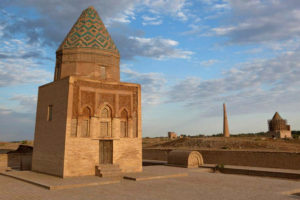
This unique architectural structure, also called the mausoleum of Fahreddin Razi, has survived miraculously and has survived to the present day. It was built before the Mongol invasion of Urgench. The shape of the mausoleum is clear and simple: the cube, it has a twelve-sided prism of the drum and an outer dome in the form of a twelve-sided tent.
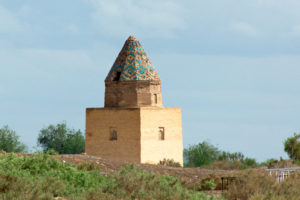
The mausoleum of Il-Arslan was manually decorated with relief carved terracotta, expressed in intricate ornamentation: plant and geometric patterns. And when performing the decor, a very special medieval technique was used. Tightly lying on the ground, not yet burned bricks were covered with clay, on which the most complicated ornament was cut out. Then the whole composition was cut at the seams between the bricks and burnt together with them, after which it was reassembled already on the facade.

So the mausoleum of Il-Arslan absolutely unique building of its era testifying the achievements of medieval architecture. It took 700 years, and this scenery continues to delight with their perfection.
Mausoleum Of Khorezmshah Tekesh
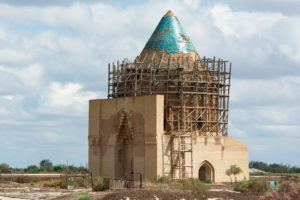
Not far from the minaret of Kutlug-Timur is the mausoleum of Khorezmshah Tekesh – one of the few surviving monuments of the pre-Mongol Urgench. In the people he is also called Sherepbaba and Gyok-gumbez. Together with the mausoleum of Il-Arslan they represent the necropolis of one of the ruling Khorezm clans.
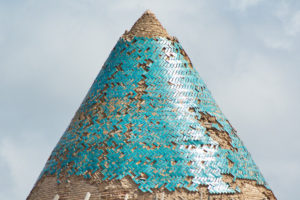
The horesmshakh Tekesh was very odious personality. He managed to unite a vast territory stretching from the Aral sea in the North to the Persian Gulf in the South and from the Pamirs in the East to the Iranian plateau in the West. In 1172, to occupy the throne, he turned for help to their former enemies – the Kara-Khitans, who agreed in exchange for annual tribute to help him to dethrone his brother, and then, having power over Khorezm, he is ordered to kill his mother.
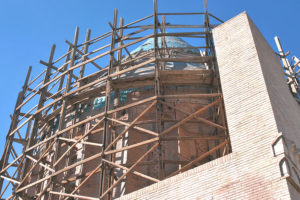
The mausoleum of Khorezmshah Tekesh once towered above the city to a height of 30 meters and was a kind of beacon in the desert. Weary travelers, wandering in the hot desert, saw him from afar and, thus, received a signal to end the hard journey.
Minaret of Mamun

 As a result of the excavation of the hill near the mausoleum of Il-Arslan, the remains of a minaret that collapsed only about a hundred years ago were discovered. In 1900 local residents found a lead plate at its base, from the text of which it follows that the minaret was built in 1011 on the orders of Shah Mamun.
Obviously, the same time is also dated to the mosque adjacent to it, from which numerous stone bases of wooden columns have been preserved
Mausoleum of Najimetdin Kubra
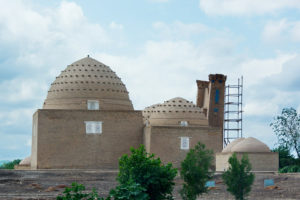
The mausoleum of Najimetdin Kubra, the founder of the Dervish order “kubraviyya” in Islam, the Sufi sheikh is the main monument in the memorial complex “360”. This place is considered sacred. Pilgrims from all over the world flock here.
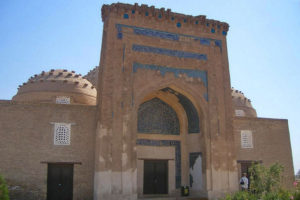
According to the legend, Khorezmshah Mohammad II executed one of the best disciples of Kubra on a false denunciation, after which the saint was very angry and cursed Khorezm. The curse soon came true – a mighty state fell as a result of the invasion of the Mongols. Kubra himself and his 360 students came out with weapons in defense of their native city. This battle was the last feat of Najimetdin for the glory of Islam: a Mongolian soldier swept the head of the great saint with a sword. In place of the patriotic feat, the cemetery was founded, where the mausoleum of Najimetdin Kubra and the mausoleums of Sultan Ali and Piryarvali are now standing. They are adjoined by a separate grave of the young man Jamiljana, the beloved disciple of Nadzhimetdin Kubra.

The mausoleum of Nadzhimetdin Kubra includes four domes: the vestibule, two meeting rooms and the gurkhan hall, in the center of which once the most beautiful tombstone was erected over the very place where the body of the feared enemy feast fell, and next to a high obelisk marked the place of the fall of his head, cut off by the Mongolian Saber. Unfortunately, during the collapse of the dome about fifty years ago, these obelisks were badly damaged and are now waiting for their restoration.
Kutlug-Timur Minaret

Grandiose, majestic, powerful… What only epithets are not heard in the address of this unique building from the middle ages. And it’s true! Reaching a height of 60 meters, the minaret of Kutlug-Timur is the tallest monument in Central Asia, “bypassed” even the mausoleum of Sultan Sanjar.

The minaret is a conical column. Slender, thin out towards the top of the round trunk is dismembered eighteen zones (stripes) painted ornament and three belts of inscriptions in kufi. In the past the minaret had a wooden Iranian lantern type burned during the fire. To the top of the minaret is a spiral staircase of 145 steps, which was only possible from the roof of the existing mosque.
The minaret of Kutlug-Timur is devoid of the rich decoration of the Central Asian minarets of the XI-XII centuries, but surpasses their daring structures: the height and slender proportions.

The scientists are still arguing about the age of the minaret. Some believe that the laying and construction of the minaret were carried out in the reign of Kutlug-Timur, on the orders of the ruler himself. Others that began to build it during the Shah Mamun (XI century). It is also known that it was built during the time of Sultan Mahmud Ghaznavi (998-1030). It is established only that it (and not the minaret of Mamun) survived after the destruction of the city by the Mongols in 1221. But the dome of the minaret, representing a valuable sample of architecture, was badly damaged and was subsequently restored.
Mausoleum of Turabek-khanym
Turabek-khanym is a real historical person, a Mongol princess, the beloved daughter of the ruler of the Golden Horde – Uzbek Khan and the wife of his viceroy in Khorezm Kutlug-Timur. Turabek-hanym was the patroness of women. Over time, she was canonized and declared a saint. The name of Turabek-khanim has always been surrounded by numerous romantic legends.
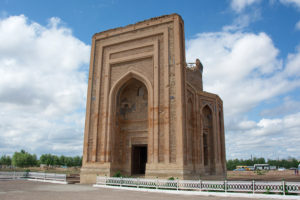
According to one of them, Turabek-khanym promised Master Gulgardan, who was in love with her, that if he built for her the most beautiful building in the world, she would marry him. Gulgardan labored to glory: he built a mausoleum, which later became the burial vault of the kings of the Sufi dynasty and Turabek-khanym itself, has amazed and still continues to amaze people with the precision of lines, the richness of interior decoration and the beauty of multicolored ornaments. But the proud beauty did not fulfill her promise, preferring the builder of the ruler of Khorezm Kutlug-Timur. Deceived master could not survive grief and rushed from the top of the mausoleum.
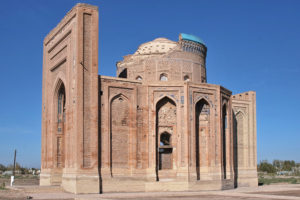
The mausoleum of Turabek-khanim really became the most magnificent structure in the entire state. A marvelous beauty and graceful structure with a rich decoration inside and out, with a surprisingly open light hexagonal hall of about a hundred square meters, decorated with carved mosaics. All this splendor was crowned with a huge dome of the mausoleum. It was, perhaps, the most perfect dome in the entire Central Asian Turan. From above it is covered with tiles – the tradition of very few buildings of that time.

The inner side of the dome is covered with a mosaic panel of the finest work with ornamentation of stars and flowers. The panel is a masterpiece of oriental art, which has no analogues in the entire medieval architecture. Above the building on a high drum with twelve openings once stood a blue glazed tent. Today, unfortunately, it can not be seen: the structure was badly damaged. But the burial-vault of Turabek-khanim was and remains the center of mass pilgrimage.
Dashmechet Madrasah
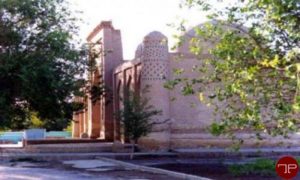
In 80 m to the east of the mausoleum of Najmeddin Kubra is the Dashmetchet madrassah. The building was erected in 1907-1908. For Muhammad-Amin at the expense of the treasury of the Khiva Khan as a madrassa, which includes the premises of the mosque.
Madrasah is a one-story building, in brick lining, with a high portal and four decorative towers in the corners. 19 living rooms (hujra) cover the courtyard along the perimeter.
Monuments of Kunya-Urgench are included in the UNESCO World Heritage List.
